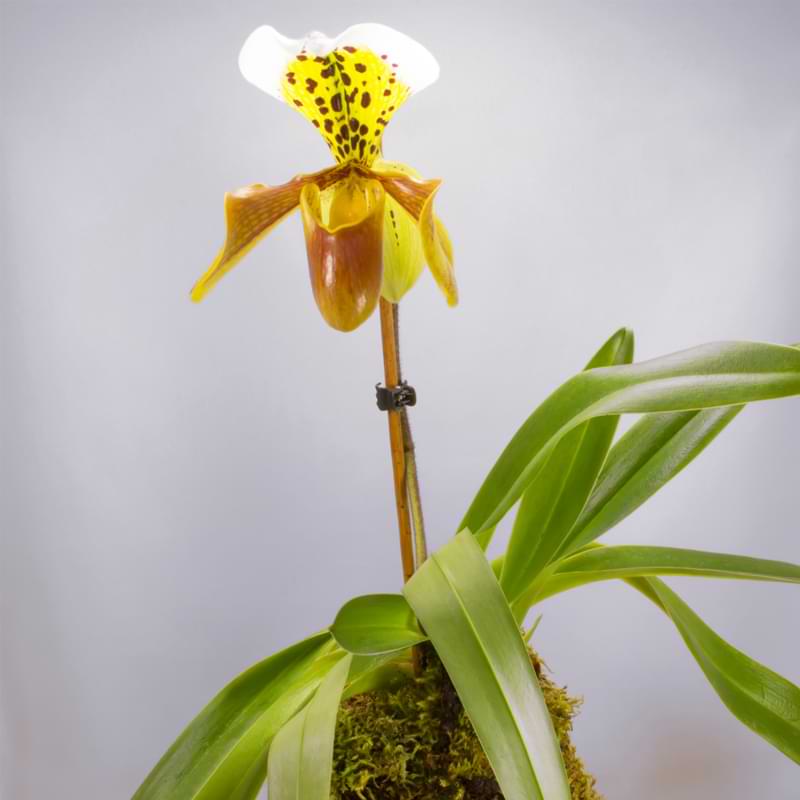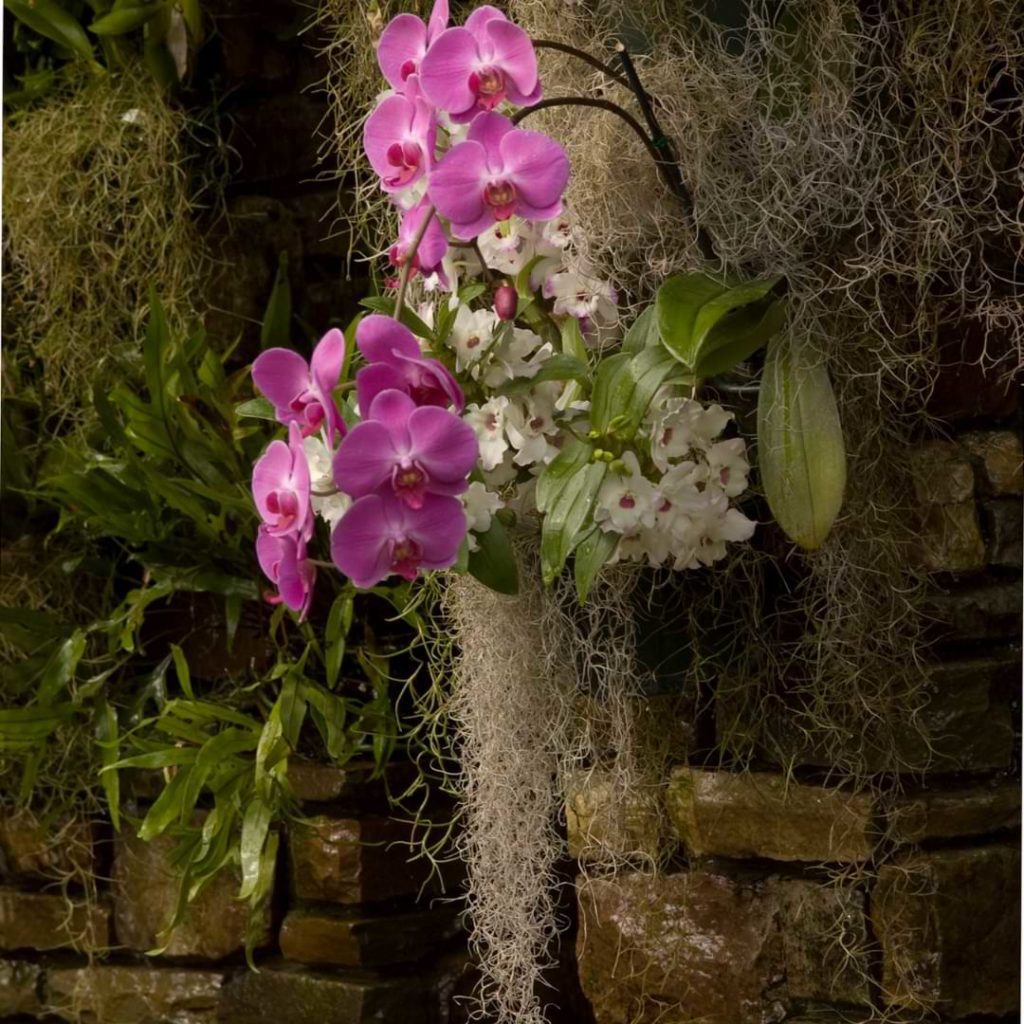Orchids look beautiful no matter how they’re displaced, but there’s something particularly attractive about mounted orchids. Mounted orchids tend to spill over their mounts beautifully and generally look fuller than potted orchids.
But mounting orchids can seem intimidating. What should you mount your orchid on, and how do you take care of mounted orchids?
While mounted orchids require different care than potted orchids and more frequent attention, mounting orchids isn’t impossible, even for beginners. Keep reading to find out what to consider before mounting an orchid and how to care for mounted orchids.
Why Mount Orchids?
Although most houseplants are typically grown in pots rather than mounted, for many orchids, mounting mimics their natural environment more closely. Many tropical orchids are epiphytic, so they grow clinging to trees or branches rather than on the ground.
Many orchids do just fine growing in pots, but mounting orchids can allow them to grow healthier root systems and thrive for years longer than they would in a pot. Mounting also eliminates the need to repot regularly. If you use a long-lasting mount, your orchid can happily stay on the same mount for years without needing to be moved.
Types of Mounts for Orchids
There are two main types of mounts for orchids: tabletop mount and wall-hung mounts. Both types have pros and cons. Continue reading to decide which one will work best for you.
Tabletop Mounts for Orchids
The benefit to tabletop mounts is that you don’t have to find wall space or equipment to hang your mount. Instead, you can place tabletop mounts on a flat surface and easily reposition them to adjust if your orchid needs more or less light.
The downside is that tabletop mounts take up more space than wall-hung mounts, and you also have to place something underneath your tabletop mount to prevent excess water from ruining your table or surface.
Wall-Hung Mounts for Orchids
A major benefit to wall-hung mounts is that they take up less space. You can fit a lot more orchids on a wall than you can place on a table or other flat surface.
The downside to wall-hung mounts is that you need a hanger for each wall-hung mount, and it’s harder to reposition wall-hung mounts once you have them in place. Also, you may not have wall space available that receives the correct amount of sunlight.

Ideas for Mounting Orchids
Orchids can be mounted on a surprisingly large variety of objects. Cork is the most popular choice for mounted orchids, followed by wood; different materials have different benefits. Take a look through the most commonly used materials for mounted orchids to decide which type of mount will work best for you.
Mounting Orchids on Rocks
While we generally think of mounting orchids on wood, it’s possible to mount orchids on rocks. Some orchids actually do grow in the crevices of stones while in the wild, and the rough surface is perfect for orchid roots to grasp.
Rock mounts can make an attractive tabletop mount for orchids, but there are a few things to be aware of. First, rock mounts can get hot very quickly when exposed to direct sunlight, so your orchid may burn if you don’t pay careful attention to where you place it. Second, pockets and crevices in the rock may hold on to too much water. This doesn’t mean you can’t successfully grow orchids mounted on rocks, it just means you need to pay attention to the growing conditions.
Tree Fern Mounting
Tree fern mounts are a classic choice for mounting orchids. Tree fern retains moisture well, which is especially good for orchids, while also allowing the air to circulate well. They can last for years as well, meaning you won’t need to move your orchid too often. However, this material can be very costly because tree ferns grow slowly. There’s also an issue with the overharvesting of tree fern material, so you’ll need to make sure that any material you buy is produced sustainably.
Mounting on Driftwood
Driftwood can make a beautiful mount for orchids. The main thing to consider when deciding whether or not to mount an orchid on a piece of driftwood is the type of wood. Make sure you aren’t using wood that will rot too quickly or you’ll have to move your orchid again too soon. If you can find driftwood from a long-lasting rot-resistant tree species, then you can use it for a beautiful tabletop mount or potentially add a hanger for a wall mount.
Note that if the driftwood came from a saltwater source, it needs to be soaked in water to remove as much salt as possible before being used for mounting orchids.
Mounting Orchids on Cork
Cork is generally considered the easiest material for mounting orchids as it’s long-lasting and you can usually reuse a cork mount for another orchid once the first orchid outgrows the mount. Cork allows for good air circulation, which helps keep your orchid’s roots healthy. Beginners, especially, are encouraged to use cork mounts.
What to Consider Before Mounting Orchids
The actual process of mounting an orchid isn’t too complicated. However, you need to be prepared before you begin mounting an orchid. Consider the following before moving on.
The Best Time to Mount an Orchid
The best time to mount matches up with the best time to repot an orchid. Orchids adapt best to a new environment when they are developing new roots. For most orchid types, spring is the best season to mount orchids. However, this can differ from one type to another. Find out what time of year is best for repotting your orchid, and then use that information to figure out when you should mount the orchid.
Selecting a Wood Mount
You’ve already seen that there are many options for orchid mounts. In addition to what we’ve already mentioned (rocks, tree fern, driftwood, cork), wood plaques or slab are also popular options. Orchids can do very well on wood mounts, but you must have the right type of wood mount for your orchid to thrive. Let’s cover a few factors before you select a wood mount for your orchid.
Can You Mount Orchids on Any Wood?
Some types of wood are better at helping your orchid grow than others, so it matters what kind of wood you mount it on. Your orchid needs wood it can grip to keep its roots secure, and the wood must be rot-resistant.
What Is the Best Wood for Orchid Mounts?
Hardwood is the best type of wood for mounting orchids. Dense wood will not break down quickly. Make sure the wood you choose doesn’t have resin and isn’t too smooth. A few good choices are oak, hickory, pecan, redwood, and citrus. There may be other natural wood options in your area that also fit the requirements for orchid mounts.
Choose Rot-Resistant Wood
Since you’ll need to water your mounted orchid almost daily, you need a wood that doesn’t rot easily when constantly exposed to moisture. A few great rot-resistant options are oak, hickory, pecan, manzanita, cedar, redwood, and douglas-fir bark.
Of course, if you have to use wood that rots more easily because there’s nothing else available, you can; however, you will need to replace the mount when the wood begins to rot. This means extra time and effort on your part as well as the possibility that you might damage your orchid’s roots when you move it to a new mount.
Leaching Salts From an Orchid Mount
Just like with any plant, excess salt can build up over time on mounted orchids. Sometimes this buildup comes from tap water or well water, but it can also happen if too much fertilizer is applied frequently.
Excess salt can damage and eventually kill orchids. To prevent this problem, you need to periodically leach salts from your orchid mount. As long as the salt buildup is minimal, you can simply soak the mount and the orchid roots in a container full of distilled water for around an hour. If needed, repeat the process the following week.
If the orchid is already suffering damage due to salt buildup, you’ll need to take more drastic steps. Remove the orchid from its mount, soak the orchid roots in distilled water for an hour, and then remount on a clean mount.

How to Make an Orchid Mount
You’ve decided you want to mount an orchid, so now it’s time to take the next steps. Here’s what to do to successfully make an orchid mount.
Tools and Equipment Needed
You’ll need to gather up a few materials before you begin the process. Your materials may differ slightly depending on what type of mount you decide to use. We recommend a cork mount if you are new to mounting orchids, but any of the options mentioned make beautiful mounts.
Mount
Select the type of mount you want to use. Decide whether you want a wall mount or a tabletop mount, and then pick the material you want to use. If you decide to use a wall mount, make sure you have a hook to keep it on the wall.
Moss
A small amount of sphagnum moss can help hold moisture near your orchid’s roots as it adjusts to being mounted rather than potted.
Pantyhose
Use strips of pantyhose, string, or wire to attach the orchid onto the mount initially. Some people use fishing line because it is less visible, but fishing line can be tricky to manipulate. Over time, the roots will grip the mount and you’ll be able to remove this material anyway.
Orchid
Select a healthy orchid to mount. We’ll discuss the best orchids for mounting further a little later in this article, so keep reading!
Preparing Your Mount
Once you have your materials together, you’re ready to prepare your mount. If you’re using a tabletop mount, you probably won’t have to do anything to get the mount ready. When you’re using a wall-hung mount, go ahead and make sure the hook is ready before you begin placing the orchid on the mount. After you’ve purchased a commercial mount, the hook may already be attached, but if you’re using a mount you’ve found or made yourself, you have to attach the hook yourself as well.
How to Secure an Orchid to a Mount
Soak your orchid’s roots in water before beginning to secure your orchid to the mount. This helps prevent damage as you attach the orchid. Lightly wrap the orchid roots in sphagnum moss. The moss will slowly fall off over time, but it helps your orchid adjust from being in a container to being mounted. The moss holds on to a little extra water for the orchid each time you water it in the beginning.
Using strips of pantyhose, string, or wire, attach the base of the orchid to your mount. Wrap the material tightly enough that the root system stays in place, but avoid accidentally cutting the roots. The pantyhose or other material will be removed once your orchid’s roots begin to grasp the mount on their own.
Where to Place an Orchid Mount
Immediately after mounting an orchid, place it in a spot that gets bright, indirect light. As the orchid adapts to its new growing environment and begins to show stable growth, you can move it to an area that gets more light. Different orchid types require different amounts of light, so you’ll need to take that into account when deciding where to place your orchid.
What Type of Orchids Can Be Mounted?
Not every type of orchid does better mounted than potted. For some orchids, potting works better in the home environment, but there are some types of orchids that absolutely thrive when mounted.
Generally, cattleya orchids are considered the best orchids for mounting. We suggest brassavola as the best option among cattleya for beginners to mounting orchids. Brassavola are somewhat drought-tolerant, so they require little less maintenance than other types of orchids.
In addition to brassavola and other types of cattleya, vanda, angraecum, tolumnia, and phalaenopsis usually work quite well as mounted orchids. Regardless of which orchid type you decide to mount, make sure it’s healthy; otherwise, it might not survive the initial transition from container to mount.
How to Care for a Mounted Orchid
Mounted orchids have somewhat different needs for care than potted orchids. While your orchid will still need roughly the same amount of light, there are a few things that will be different once you mount an orchid.
Watering a Mounted Orchid
The major factor to be aware of when mounting orchids is that they typically need more frequent watering than potted orchids. A mounted orchid’s need for water will vary depending on environmental conditions, like light, heat, air circulation, and humidity, but most mounted orchids will need to be watered almost daily, or at least 3 to 5 times a week. Indoor mounted orchids can survive a few days without water, but this can stress the plant and should not be done often.
The best way to water a mounted orchid is to take it to the sink and run it under water for a few minutes. Let the orchid sit for several more minutes before returning the orchid so that excess water doesn’t ruin the surface where you keep your orchid mounted.
The good news is that it’s much more difficult to overwater a mounted orchid than a potted orchid. You should rarely see issues with root rot on mounted orchids.
Fertilizing Mounted Orchids
To help your mounted orchid thrive, apply a gentle, diluted fertilizer every 2 to 3 weeks once you notice new root growth after mounting. Remember that too much fertilizer can allow excess salts to build up on the mounted orchid. If it seems like you need to fertilize more often, gradually increase the frequency. Orchids grown as houseplants need fertilizer to thrive because they don’t have access to the same amount of nutrients as they would in their natural environment, but most people tend to go too heavy on fertilizer. If you use too little fertilizer, you can easily fix that problem, but using too much fertilizer will harm your orchid quickly, and the damage can be difficult to reverse.
Mounting Orchids FAQ
FAQ: Are mounted orchids better than potted orchids?
Some orchids are much better mounted than potted, but it depends on the type of orchid and whether you are committed to watering your mounted orchid frequently. If you are able to provide frequent watering and enough humidity, some orchid types will be much healthier and more beautiful mounted instead of potted.
FAQ: Can any orchid be mounted?
Not all types of orchids should be mounted. Cattleya and phalaenopsis orchids are the most commonly mounted orchids. Mounted orchids need to have a higher tolerance of drought when grown in the home environment.
FAQ: Is misting orchids a good idea?
You can mist mounted orchids to help provide more humidity, however, this only temporarily raises the humidity level around the orchid. You’ll still need to water your mounted orchid just as often even if you are misting as well.
FAQ: Can you overwater a mounted orchid?
It’s not easy to overwater a mounted orchid. Since the roots are exposed, there’s no medium to hold on to extra water. Unlike potted orchids, keeping mounted orchids adequately watered tends to be more of a concern than overwatering.
Join Our Orchid Care Facebook Community
In our Facebook group of orchid lovers, we’re dedicated to creating a rich and engaging environment where plant lovers can come together and share tips, tricks, and experiences.
If you’re an orchid lover, come join our Facebook community! We can’t wait to celebrate your successes and help you troubleshoot your care routine.
For continued success, you can explore our other articles or visit our online shop for plant care products that are sure to keep your plants boasting rich green leaves and big, bountiful blooms year-round.
More Great Orchid Resources



